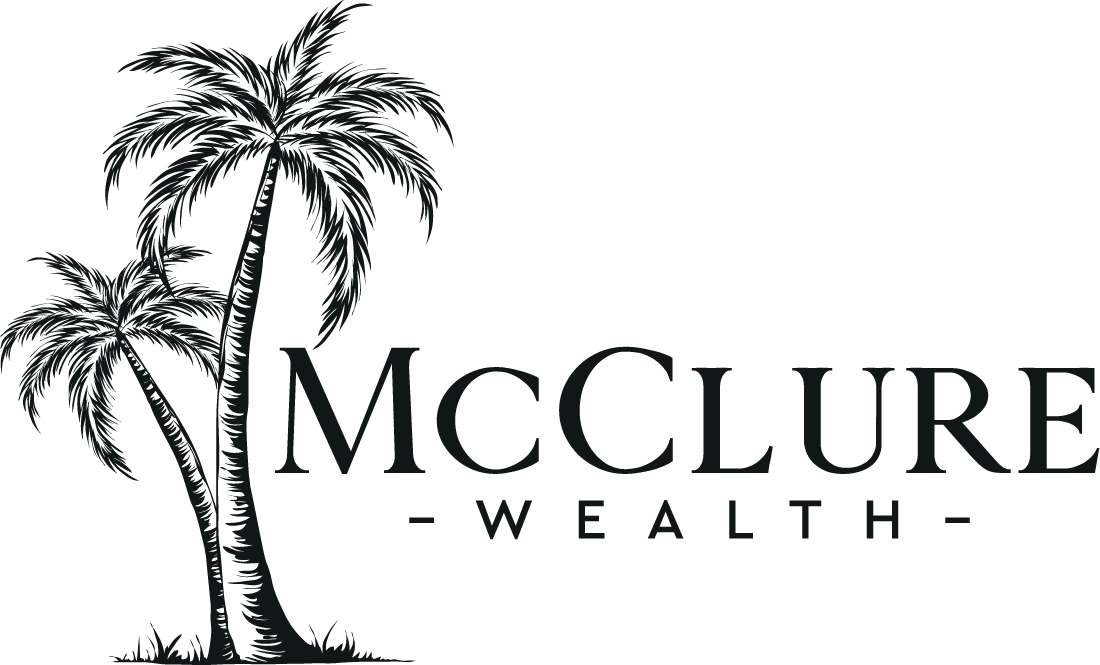By Ed McClure, CFP®, PPC®
As the countdown to 2024 begins, are your finances in order, or are you unprepared? At McClure Wealth, we know that solid financial well-being doesn’t just happen overnight. It takes hard work, diligence, and consistency to improve your finances, strengthen your savings, and plan for the future. That’s why we’ve put together this comprehensive financial planning guide for the new year. Read on to learn more about the steps you can take to jump-start your financial plan for 2024.
Retirement
Maximize Your Retirement Savings
Before the end of the year, be sure to max out your retirement contributions. Many employers offer retirement plans like 401(k)s, 403(b)s, and 457s, which allow you to contribute up to $22,500 annually for 2023 ($30,000 if over age 50).
These contributions are automatically deducted from your paycheck and won’t show up as part of your annual income, so the more you can maximize your contributions during the year, the less taxable income you will have come April 15th. With this strategy, you can defer taxes until your retirement years when you could potentially be in a lower tax bracket.
Contribute to a Traditional IRA
Contributing to a traditional IRA is another strategy to reduce your AGI if your income is within certain limits. By contributing pre-tax funds, you can effectively reduce your current-year tax liability, but you will owe tax on both the contributions and the account growth when you withdraw the funds in retirement. The 2023 contribution limit for traditional IRAs is $6,500 with additional $1,000 catch-up contributions for individuals over the age of 50. Contributions can be made until April 15th, 2024, for the 2023 tax year, but the sooner they are made, the less likely you are to forget.
Don’t Forget About RMDs
If you are age 73 or older, you are required to take minimum distributions from all of your retirement accounts (except Roth IRAs). In the year in which you turn 73, you have until April 1st of the following year to take your RMD. Every year thereafter, however, you must take the distribution no later than December 31st.
If you haven’t yet taken your RMD for 2023, be sure to do so. If you don’t, you will face a 50% penalty on the distribution you should have taken. If you don’t need your RMD money to live on, consider donating the funds to a worthy cause, which could also lessen your tax burden for the year. To calculate your RMD, use one of the IRS worksheets.
Cash Flow
Assess Your Emergency Fund
Now is the time to confirm you have enough money set aside in your emergency fund or create a plan to build this up over the next year. An adequate emergency fund should cover 3-6 months of necessary living expenses, including mortgage or rent, utilities, groceries, transportation, etc.
With all the stock market uncertainty and recession fears, many experts have suggested maintaining a larger emergency fund, closer to 6-12 months of expenses. If you’re single, or your household only has one source of income, consider saving on the higher end of this scale to make sure you’re covered in the event of a job loss or reduction in income.
However much you save, be sure this money is held in a highly liquid account. It needs to be readily available and easily accessible, but it should also be in an account that offers a competitive interest rate so you don’t lose out on potential growth.
Create and Maintain a Budget
The word “budget” seems to have a negative connotation; many people think that if you budget, you’re broke. Budgeting actually gives you permission to spend and is a simple way to keep track of your expenses and be aware of how much you’re actually saving each month. If one of your goals for the new year is to improve your cash flow and make better financial decisions, creating and maintaining a budget is a great place to start.
Risk Management
Contribute to a Health Savings Account
If you’re enrolled in a high-deductible health plan, consider contributing to a health savings account (HSA) before the end of the year. HSAs offer triple tax savings. Contributions are tax-deductible, earnings grow tax-free, and withdrawals are tax-free if used to pay for medical expenses.
The 2023 IRS contribution limits for HSAs are $3,850 for individuals and $7,750 for families. If you are 55 or older, you may also be able to make catch-up contributions of $1,000 per year. You technically have until April 15th for your contributions to count for the previous year’s tax return, but the sooner, the better to ensure you don’t forget.
Review Your Workplace Benefits
The end of the year is a great time to review your workplace benefits and take advantage of any remaining sick days, vacation time, or deductibles before they reset.
Depending on your company, your sick or vacation time might expire at the end of the year. Check with your HR department to learn about any expiration dates. If your sick or vacation time does expire, be sure to take advantage of a last-minute vacation or a staycation before the end of the year.
Similarly, if you’ve hit your deductible for the year, now would be a good time to incur additional medical expenses before your deductible resets in 2024. Take the time to get that dental work, blood test, or other medical procedure you’ve been putting off. Dental plans in particular often have a maximum coverage amount. If you haven’t used up the full amount and anticipate any treatments, make an appointment before December 31st.
Use Up Your Flexible Spending Account
Unlike HSAs, flexible spending accounts (FSAs) have limits on how much you can carry over from year to year. Because of that, you’ll want to use up as much of your FSA dollars as possible by the end of the year. In 2023, you are only allowed to carry over $610 going into 2024.
That being said, check the restrictions on your account to see what the money can and cannot be used for, and take care of any needs you may have as allowed by your plan.
Revisit Your Plans and Policies
Your insurance needs may also change as the year goes by, so periodically review your coverages and designated beneficiaries to bring them up to date to reflect your current financial situation. For example, if you paid off debt, you may not need as much life insurance coverage since your family’s liabilities have decreased. You might also want to evaluate your need for other types of insurance, such as long-term care or disability insurance.
Taxes
Donate to Charity
Annual gifts to qualified charitable organizations may be deemed an eligible itemized deduction and can be a great way to give back at the end of the year while also minimizing your tax bill. With the higher standard deduction, you’ll need to make sure your total itemized deductions for the year exceed $13,850 for an individual filer, and $27,700 for married filing jointly. If your deductions fall below this amount, consider bunching your giving or doing several years’ worth of giving in one year.
Donor-advised funds are another option that allow you to contribute a lump sum all at once and then distribute those funds to various charities over several years. With this strategy, you can itemize deductions when you make the initial contribution and then take the standard deduction in the following years, allowing you to make the most out of your donation tax-wise.
Invest in a College Savings Plan
If you have children or grandchildren in your life, contributing to a 529 savings plan is an excellent way to jump-start their college savings and give a thoughtful holiday gift that will last longer than a few months.
This type of educational savings plan was created so that families can receive tax benefits for saving toward qualified higher-education expenses. After-tax money is invested in a 529 plan where it grows tax-free. When the money is later taken out for qualified expenses, there are no federal taxes due.
In 2023, you can give up to $17,000 per 529 account gift-tax-free. There’s also a special election that allows you to give 5 years’ worth of contributions as a lump sum, meaning you could give up to $85,000 entirely gift-tax-free!
Consider a Roth Conversion
Roth IRAs are an attractive savings vehicle for many reasons, including no required minimum distributions (RMDs), tax-free withdrawals after age 59½, and the ability to pass wealth tax-free to your heirs. Unfortunately, Roth IRAs have income restrictions, and you may not be able to open an account outright if you are above certain limits.
To get around this threshold, consider a Roth conversion. Using this strategy, you will pay tax on money contributed to a traditional IRA, thereby converting it into a Roth. If you have earned less income in 2023, or your traditional IRA balance has taken a hit due to recent market volatility, a Roth conversion may be a great opportunity for your specific situation. Converting to a Roth also allows your money to grow tax-free for as long as you’d like.
Consider Tax-Loss Harvesting
Tax-loss harvesting involves selling investments at a loss in order to offset the gains in your portfolio. By realizing a capital loss, you are able to counterbalance the taxes owed on capital gains. The investments that are sold are usually replaced with similar securities in order to maintain the desired asset allocation and expected return. Given the continued market volatility throughout 2023, this can be a great way to make the most out of a losing situation by using an investment loss to offset your tax liability. Talk with your advisor about potentially harvesting your losses and if it makes sense for you. Any appropriate actions must be taken by December 31st.
Investments
Review Your Asset Allocation & Invest With Impact
The end of the year is also a great time to review your asset allocation strategy and incorporate ESG and impact investing if desired. Given the dramatic market volatility and historic levels of inflation over the last year, it’s crucial to evaluate your investments and make sure your portfolio is properly diversified. It should also be tailored to your specific risk tolerance level, ensuring you earn enough returns to keep up with inflation but you’re not overexposing yourself to risk.
If you are interested in using your funds to support environmental, social, or governmental issues (ESG), you can also consider impact investing as a way to earn returns while also promoting change on causes you care about.
Estate Planning
Review Beneficiary Designations
If you had any major life events happen this year, like a birth of a child, marriage, divorce, or a death in the family, make sure you review your beneficiary designations. There are several assets, including retirement accounts, bank accounts, life insurance policies, that are distributed based on beneficiary designation and not the terms of the will. If you have an updated will but an outdated beneficiary listed on one of these accounts, there is a chance your assets will not pass according to your wishes.
Review Your Estate Documents
Similarly, it’s important to review your estate planning documents, including your last will and testament, any powers of attorney, living wills, and/or trust documents. The new year is always a good time to take another look at these documents or start drafting them if you don’t already have them in place.
Make the Most of the Annual Gift Tax Exclusion
If you’re in the giving spirit as you head into the new year and you want to reduce your taxable estate, consider making gifts up to the annual exclusion amount. In 2023, individuals can give to each recipient (and to an unlimited number of recipients) up to $17,000 and married couples can give up to $34,000 without triggering gift tax. Not only that, but the beneficiary of your gift will not have to report it as income. This is a great way to spread your wealth amongst family and friends.
We’re Here to Help
If you’re looking at this list and feeling overwhelmed, we’re here to help. We at McClure Wealth have the tools and knowledge to help clients get their financial house in order. With our extensive industry experience, our goal is to help clients improve their financial plans and get the most out of life. Call (760) 607-0611 to set up a complimentary get-acquainted meeting so we can see if we are a good fit!
About Ed
Ed McClure is a CERTIFIED FINANCIAL PLANNER™ practitioner, Professional Plan Consultant® (PPC®), and founder of McClure Wealth Management. With over 25 years of experience, Ed works with business owners who want to maximize their retirement plan benefits, businesses that need help setting up and managing a 401(k) for their employees, and families who want guidance while planning their futures. He is known for simplifying complicated and intimidating topics and making wealth management concepts easy for others to remember and understand.
Ed has established himself as a trusted resource for business owners and individuals, and his mission is to help his clients achieve the financial independence and well-being they deserve so they can give their time and energy to the people and things they love. He has a bachelor’s degree in finance from the University of Illinois. In his spare time, Ed conducts financial workshops for the Just In Time for Foster Youth organization, which helps equip young men and women as they come out of the foster care system. He also loves to travel and spend time with his favorite people. To learn more about Ed, connect with him on LinkedIn.
No investment strategy can guarantee a profit or protect against loss. This material is not intended to replace the advice of a qualified tax advisor, attorney, and accountant or insurance advisor. Consultation with the appropriate professional should be done before any financial commitments regarding the issues related to the situation are made. While you can use the funds in an HSA at any time to pay for qualified medical expenses, you may contribute to an HSA only if you have a High Deductible Health Plan (HDHP) — generally a health plan (including a Marketplace plan) that only covers preventive services before the deductible. Some health insurance companies offer HSAs for their HDHPs. Check with your company. You can also open an HSA through some banks and other financial institutions. Source https://www.healthcare.gov/glossary/health-savings-account-hsa/
Qualified distributions from Roth IRA accounts are tax and penalty-free if the first Roth contribution was made at least five years before, and if you are at least 59-1/2, are disabled or have deceased. For non-qualified distributions from Roth IRA accounts, earnings are taxable and may be subject to a 10% early withdrawal penalty. If converting a Traditional IRA to a Roth IRA, you will owe ordinary income taxes on any previously deducted Traditional IRA contributions and on all earnings. We suggest that you discuss tax issues with a qualified tax advisor. The returns on a portfolio consisting primarily of Environmental, Social and Governance (“ESG”) aware investments may be lower or higher than a portfolio that is more diversified or where decisions are based solely on investment considerations. Because ESG criteria exclude some investments, investors may not be able to take advantage of the same opportunities or market trends as investors that do not use such criteria.





